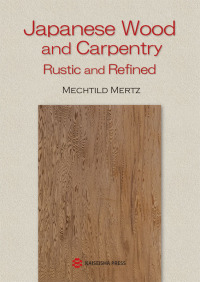
|
本のご注文 | 書店様へ |

|
| ホーム | 出版目録 | 書評・紹介記事 | 常備店 | リンク集 | English |
Japanese Wood and CarpentryRustic and Refined
内容紹介日本の宮大工・数寄屋大工・建具屋・大工らの木材利用法を解説(英文)。資料として1876年のフィラデルフィア万国博覧会で披露された「有用木材捷覧」から特に重要な樹種について抜粋して掲載。木工芸についての英語-日本語対照用語集付。
Drawing attention to the wood species used by Japan's carpenters, Japanese Wood and Carpentry, Rustic and Refined, reveals the ingenious ways in which Japanese carpenters exploit the extraordinary diversity of their country's forest resources. Its first part introduces four types of Japanese carpenters – temple and shrine carpenters, carpenters of refined teahouses and residences, joiners of doors, windows and screens, and general carpenters – and details the wood species used by each. In its second part, the book grants the modern-day reader access to a rare document: the Yûyô Mokuzai Shôran handbook, a guide to Japanese wood species prepared by the Meiji government for the 1876 Philadelphia Exhibition. Full-size facsimiles of thirty-two of the handbook's samples furnish an in-depth look at some of the important wood species used in Japanese architectural construction. Together, the two parts make for an indispensable resource for anyone interested in learning more about Japan’s fascinating ‘culture of wood’. 主要目次Foreword
Acknowledgments Notes on Typography Chronological Table of Japanese Historical Periods Introduction Part I Japanese Carpenters and the Wood They Employ 1. Miya-daiku, Temple and Shrine Carpenters Large-Diameter Domestic Timber for Temples and Shrines Substitutes for Large-Diameter Hinoki Cypress 2. Sukiya-daiku, Carpenters of Refined Teahouses and Residences Chashitsu Finishing Techniques and Materials The Tokonoma Wood Species of the Katsura Imperial Villa 3. Tateguya, Joiners of Doors, Windows, and Screens Techniques and Materials Usage of the Outer Shirata Sapwood of Cedar Usage of the Inner Akami Heartwood of Cedar Fusuma and Byôbu Frames: Techniques and Wood Species A Tsuitate 4. Daiku, General Carpenters The Kamiseya Farmhouse A Weaver’s House from the Kiso District A Kyoto Machiya Part II Facsimiles of Thirty-Two Pages from the Yûyô Mokuzai Shôran Handbook Epilogue Appendices Names of Timber, Trees, and Plants Used in Traditional Japanese Architecture Complete List of Woods Mentioned in the Yûyô Mokuzai Shôran Handbook Maps of Old Japanese Provinces and Modern Japanese Prefectures Glossary Bibliography Index of Timber and Tree Names 執筆者紹介メヒティル・メルツ (Mechtild MERTZ)
ハイデルベルク大学、次にソルボンヌ大学で日本研究と東アジア美術史を専攻。ピエール・エ・マリー・キュリー大学(パリ)で木材の解剖学を学び、国立自然史博物館(パリ)で民族植物学の博士号取得。 15年以上にわたり、京都大学の生存圏研究所(旧木材研究所)で共同研究者として従事。 2018年よりパリの国立科学研究センター(CNRS)の東アジア文明研究センター(CRCAO)研究員。
Mechtild Mertz After having trained as a cabinetmaker in Germany, Mechtild Mertz took courses in Japanese Studies and East Asian Art History, first at the University of Heidelberg and then at the Sorbonne University. She studied wood anatomy at Pierre-et-Marie-Curie University (Paris) and obtained a PhD in ethnobotany at the National Museum of Natural History (Paris). For over fifteen years she has been a Cooperative Researcher at Kyoto University’s Research Institute for Sustainable Humanosphere (formerly the Wood Research Institute). Since 2018 she has been a Researcher specializing in Asian religious wooden sculpture at the East Asian Research Centre (CRCAO) of the National Centre for Scientific Research (CNRS) in Paris.
|














